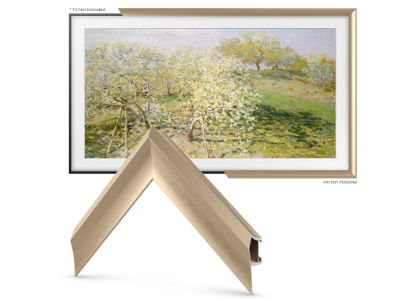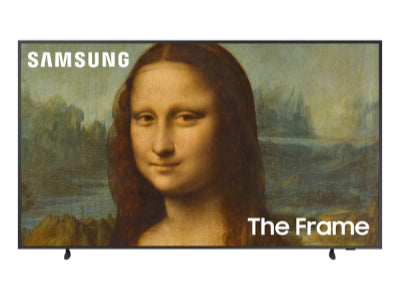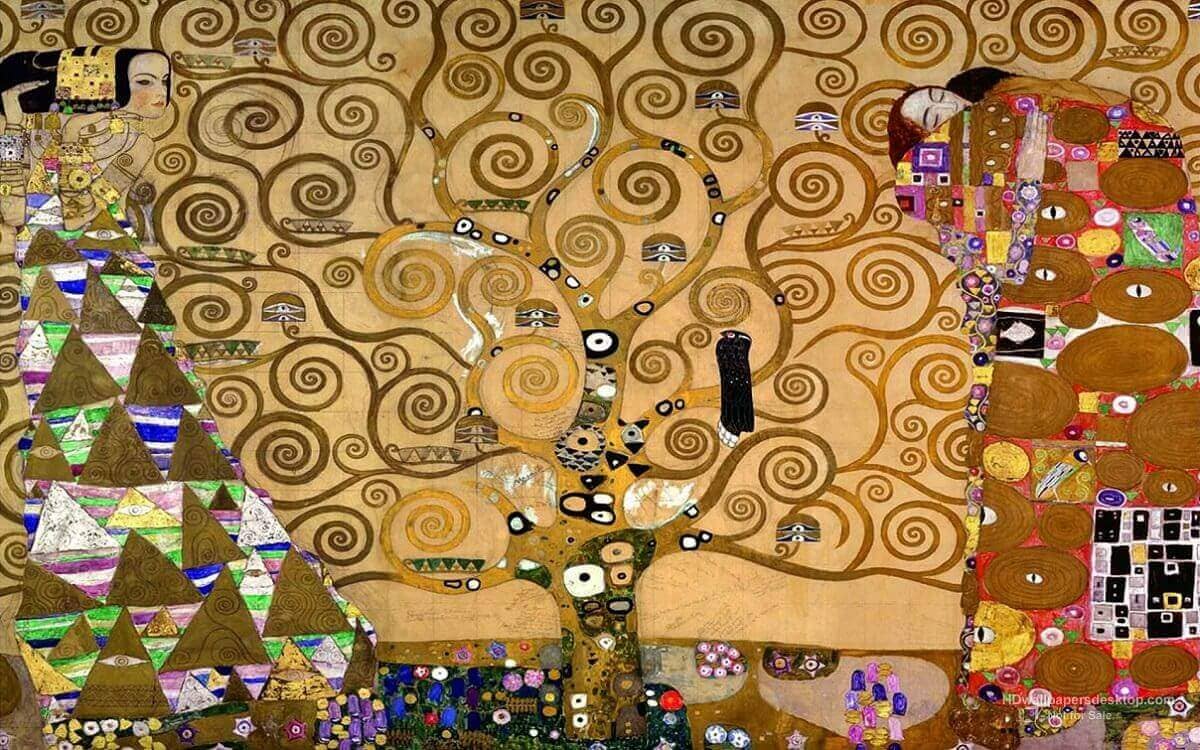A Journey Through Some of Art's Most Striking Patterns
Patterns are everywhere in art, even when it initially looks like chaos. From the swirling branches of a tree to the precise geometry of computer-created concentric squares, patterns have a way of drawing our eyes across the canvas and into the artist's world.
They can be decorative, symbolic, or optical illusions that fool our perceptions. But no matter how the artist uses them or we interpret them, they're never just background noise: They're often the heartbeat of the work, carrying its rhythm and meaning.
We'll look at six of our favorite paintings to show how patterns are used to great effect in telling an artist's story. These paintings aren't just visually stunning — they're windows into the minds of some of history's most innovative creators, including Gustav Klimt, Jackson Pollock, and Bridget Riley.
1. "The Tree of Life" - Gustav Klimt (1905)
Gustav Klimt's "The Tree of Life," created between 1905 and 1909, is a stellar example of Art Nouveau. It's the only landscape he painted during his "Golden Period." The central figure is a tree, its branches spiraling across the canvas, reaching out toward the humans on either side: a woman to the left seems to be watching the couple embracing on the right, reminiscent of Klimt's other famous painting, "The Kiss."
The tree represents the connection between Heaven, Earth, and the underworld, and Klimt's use of gold leaf gives the painting an almost divine quality, as if we're peering into a magical realm. Some art critics believe The Tree of Life symbolizes unity, others consider it an expression of masculine and feminine. Still others say, "the painting symbolizes the union between man's greatest virtues, which are strength, wisdom, and beauty. The tree reaching for the sky is a symbol of man's perpetual yearning for becoming more, yet his roots are still bound to the earth. "
And sometimes, to paraphrase Freud, a tree is just a tree.
Klimt was an Austrian painter and one of the central figures in the Art Nouveau movement, also called the Vienna Secession. It comprised a group of artists who rejected academic art in favor of innovation and symbolism.
Klimt was a big believer in symbolism and exploring universal themes, and The Tree of Life (which represents cosmic harmony) is filled with it, from the branches (life) to the birds (messengers), the people (different aspects of humanity), their clothing, and even the eyes peering out from the tree and the patterns (order and structure of the universe). He wanted to express ideas about life, death, and spirituality.

2. "Nataraja" - Bridget Riley (1993)
Fast forward to 1993 and Bridget Riley's "Nataraja," which is an example of Op Art, or Optical Art. It's a style that emerged in the 1960s, and it relied on its use of optical illusions to create its visual effects and to create sensations of movement, vibration, and depth. Bridget Riley is considered one of the key figures of the Op Art movement.
Riley is known for her optical illusions that seem to move and shimmer on the canvas. "Nataraja" features a series of diagonal stripes in a variety of colors. At first look, it might just seem like simple stripes and blocks, but as you look closer, you'll see how Riley uses color relationships to create a sense of movement.
The title of the painting refers to a depiction of the Hindu god Shiva as the cosmic dancer, and his dance represents the flow of energy in the universe. So, too, does Riley's painting pulse with its own inner life. The angular lines and varying widths of the stripes create the pulse and lead the eye in multiple directions. The colors have been carefully placed in terms of their correspondence or contrast to the surrounding colors. There's no central focus or objects to draw your eye; it's drawn everywhere at once in a mad scramble to find a single anchor point to focus on.

3. "Homage to the Square" - Josef Albers (1962)
Josef Albers' "Homage to the Square" is a series of geometric abstract paintings that feature a series of nested squares in different shades of colors, either sharply contrasting or closely related, to create a sense of depth and visual tension.
Albers, who was born in Germany and emigrated to the United States in 1933, was a key figure in the development of geometric abstraction.
By using simple shapes and a limited color palette, Albers was able to create a visual dialogue that invited the viewer to consider the interaction between colors and shapes. While they seem fairly simple, the paintings have a profound impact on our perception. Our eyes adjust to the different shades and hues, creating an almost hypnotic effect.
Albers' artistic philosophy extolled the transformative power of color, believing that abstraction was more "real" than nature. His series "Homage to the Square" began in 1949 and culminated with his final piece, "Homage to the Square: R-37," in 1962, containing various shades of red, creating an optical effect that shifts as you look at it.
Rather than depicting a central tree or area of focus, R-37 — all of the Homage to the Square series, really — focuses entirely on color relationships and spatial harmony. The paintings became a cornerstone for the Modernist exploration of color theory, and it influenced Minimalism and Color Field painting.
By exploring color theory, Albers is able to demonstrate how even the most basic geometric forms can evoke deep emotional responses.
After all, we're talking about it.

4. "Autumn Rhythm (Number 30)" - Jackson Pollock (1950)
"Autumn Rhythm (Number 30)" is a prime example of Jackson Pollock's famous "drip" method, where he would pour or spatter paint onto a canvas laid on the floor, which let him see the canvas from all angles. The results were complex, web-like patterns that seemed to dance and explode on the surface.
At first glance, "Autumn Rhythm" might appear chaotic — black and white spatters on a beige canvas. But as you continue to watch it, you'll see a rhythm inside the chaos. The ropes and splatters of paint create a sense of energy. Pollock's technique let him capture the very act of creation, turning the process of painting into a performance.
It's almost proof of Pollock's energy and movement. Other paintings by other artists are a result of that artist's work and skill, but Autumn Rhythm is a visual representation of Pollock's emotions and impulses — an instant replay of his mind.
Pollock once said, "I am nature," which emphasized his belief in the artist as a conduit for primal creative forces. "Autumn Rhythm (Number 30)" immerses us in a web of interlacing lines and splatters. Like most of the paintings we've mentioned here, there's no central focal point or representational imagery. The entire canvas became an arena for Pollock's dance.
While you might think, "My kid could do that!" "Autumn Rhythm (Number 30)" has been recognized as a seminal work of Abstract Expressionism thanks to its boldness, scale, and ability to evoke the rhythms and patterns of nature.

5. "The Marriage of Reason and Squalor, II" - Frank Stella (1959)
Frank Stella's "The Marriage of Reason and Squalor, II," created in 1959, is the quintessential minimalist masterpiece. The painting consists of black bands painted on a white canvas that form an upside-down "U" shape — or is it thin white lines on a black canvas? The thin white lines between the black bands create a subtle but powerful pattern, sort of like a gangster's pinstripe suit.
Stella hails from Massachusetts and is considered a revolutionary figure in abstract art. His philosophy was based on the idea that a painting should be an object in itself, not a medium for emotional expression or storytelling.
He once said, "What you see is what you see," meaning that he rejected the idea that art needs to represent anything beyond its own physical presence. To paraphrase Freud (again), "sometimes a painting is just a painting." That means there is no hidden meaning inside this work; it is exactly what it appears to be: black bands painted on a white canvas.
"The Marriage of Reason and Squalor, II" — which implies there was a previous "The Marriage of Reason and Squalor" — and other works in his "Black Paintings" series marked the beginning of Minimalism and launched him to prominence.
Stella was only 23 years old when "The Marriage of Reason and Squalor, II" was exhibited at the Museum of Modern Art's Sixteen Americans show in 1959.

6. "Rhythm Colour no. 1076" - Sonia Delaunay (1939)
Sonia Delaunay's "Rhythm Colour no. 1076" is a vibrant example of abstract art filled with geometric patterns. She uses circles, semicircles, and rectangular shapes of bright reds, blues, yellows, and greens in repeating patterns to create a sense of rhythm and movement.
Sonia Delaunay developed a style called "Simultanism" in conjunction with her husband Robert, which explored the interaction of colors and shapes, much like Josef Albers (above). We see the theory in action with "Rhythm Colour no. 1076," as the shapes overlap and the colors contrast to create a painting that seems to shift and change as we look at it.
The painting is an example of Delaunay's abstract style, arranging circles and semicircles into a symmetrical pattern around a central axis. Unlike some of the other paintings we've discussed, there is a central focal point, even if it is an abstract one. The lines and objects are all — somewhat — symmetrical in nature, drawing the eye to the center of the piece until it bounds back outward along any of the angles.
Delaunay believed that color could replace words in creating poetic expressions, which is why she referred to works like this as Rhythm Colour as a way to emphasize the musical/poetic quality of her work.
When it was unveiled, "Rhythm Colour no. 1076" was well-received and helped her become recognized as a key figure in the Parisian avant-garde, not only in fine art but in applied design: Delaunay was noted for her work in fashion, textiles, and interior design as well.

As we’ve seen through these six extraordinary works, patterns are more than just whimsical decorations. They're tools for storytelling and emotional resonance, or in Frank Stella's case, black bands on a canvas.
Each artist used patterns in their own way, whether it was to get your attention or to stir emotions. But all of them remind us that art is as much about what we feel as what we see.
Patterns speak to something universal in human creativity, namely, the need to find order in chaos and beauty in repetition. Maybe you can spend time finding that order and beauty by loading one of these onto your Samsung Frame TV.
![]()













